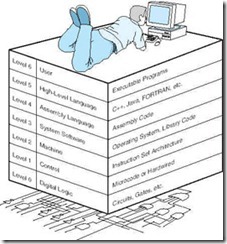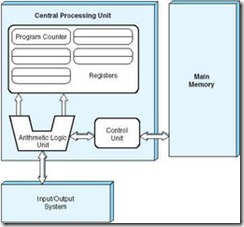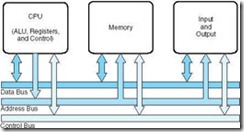1.6 The Computer Level Hierarchy
If a machine is to be capable of solving a wide range of problems, it must be able to execute programs written in different languages, from FORTRAN and C to Lisp and Prolog. As we shall see in Chapter 3, the only physical components we have to work with are wires and gates. A formidable open space—a semantic gap—exists between these physical components and a high-level language such as C++. For a system to be practical, the semantic gap must be invisible to most of the users of the system.
Programming experience teaches us that when a problem is large, we should break it down and use a “divide and conquer” approach. In programming, we divide a problem into modules and then design each module separately. Each module performs a specific task and modules need only know how to interface with other modules to make use of them.
Computer system organization can be approached in a similar manner. Through the principle of abstraction, we can imagine the machine to be built from a hierarchy of levels, in which each level has a specific function and exists as a distinct hypothetical machine. We call the hypothetical computer at each level a virtual machine. Each level’s virtual machine executes its own particular set of instructions, calling upon machines at lower levels to carry out the tasks when necessary. By studying computer organization, you will see the rationale behind the hierarchy’s partitioning, as well as how these layers are implemented and interface with each other. Figure 1.3 shows the commonly accepted layers representing the abstract virtual machines.
Level 6, the User Level, is composed of applications and is the level with which everyone is most familiar. At this level, we run programs such as word processors, graphics packages, or games. The lower levels are nearly invisible from the User Level.
Level 5, the High-Level Language Level, consists of languages such as C, C++, FORTRAN, Lisp, Pascal, and Prolog. These languages must be translated (using either a compiler or an interpreter) to a language the machine can understand. Compiled languages are translated into assembly language and then assembled into machine code. (They are translated to the next lower level.) The user at this level sees very little of the lower levels. Even though a programmer must know about data types and the instructions available for those types, she need not know about how those types are actually implemented.
Level 4, the Assembly Language Level, encompasses some type of assembly language. As previously mentioned, compiled higher-level languages are first translated to assembly, which is then directly translated to machine language. This is a one-to-one translation, meaning that one assembly language instruction is translated to exactly one machine language instruction. By having separate levels, we reduce the semantic gap between a high-level language, such as C++, and the actual machine language (which consists of 0s and 1s).
Level 3, the System Software Level, deals with operating system instructions. This level is responsible for multiprogramming, protecting memory, synchronizing processes, and various other important functions. Often, instructions translated from assembly language to machine language are passed through this level unmodified.
Level 2, the Instruction Set Architecture (ISA), or Machine Level, consists of the machine language recognized by the particular architecture of the computer system. Programs written in a computer’s true machine language on a hardwired computer (see below) can be executed directly by the electronic circuits without any interpreters, translators, or compilers. We will study instruction set architectures in depth in Chapters 4 and 5.
Level 1, the Control Level, is where a control unit makes sure that instructions are decoded and executed properly and that data is moved where and when it should be. The control unit interprets the machine instructions passed to it, one at a time, from the level above, causing the required actions to take place.
Control units can be designed in one of two ways: They can be hardwired or they can be microprogrammed. In hardwired control units, control signals emanate from blocks of digital logic components. These signals direct all of the data and instruction traffic to appropriate parts of the system. Hardwired control units are typically very fast because they are actually physical components. However, once implemented, they are very difficult to modify for the same reason.
The other option for control is to implement instructions using a microprogram. A microprogram is a program written in a low-level language that is implemented directly by the hardware. Machine instructions produced in Level 2 are fed into this microprogram, which then interprets the instructions by activating hardware suited to execute the original instruction. One machine-level instruction is often translated into several microcode instructions. This is not the one-to-one correlation that exists between assembly language and machine language. Microprograms are popular because they can be modified relatively easily. The disadvantage of microprogramming is, of course, that the additional layer of translation typically results in slower instruction execution.
Level 0, the Digital Logic Level, is where we find the physical components of the computer system: the gates and wires. These are the fundamental building blocks, the implementations of the mathematical logic, that are common to all computer systems. Chapter 3 presents the Digital Logic Level in detail.
1.7 The Von Neumann Model
In the earliest electronic computing machines, programming was synonymous with connecting wires to plugs. No layered architecture existed, so programming a computer was as much of a feat of electrical engineering as it was an exercise in algorithm design. Before their work on the ENIAC was complete, John W. Mauchly and J. Presper Eckert conceived of an easier way to change the behavior of their calculating machine. They reckoned that memory devices, in the form of mercury delay lines, could provide a way to store program instructions. This would forever end the tedium of rewiring the system each time it had a new problem to solve, or an old one to debug. Mauchly and Eckert documented their idea, proposing it as the foundation for their next computer, the EDVAC. Unfortunately, while they were involved in the top secret ENIAC project during World War II, Mauchly and Eckert could not immediately publish their insight.
No such proscriptions, however, applied to a number of people working at the periphery of the ENIAC project. One of these people was a famous Hungarian mathematician named John von Neumann (pronounced von noy-man). After reading Mauchly and Eckert’s proposal for the EDVAC, von Neumann published and publicized the idea. So effective was he in the delivery of this concept that history has credited him with its invention. All stored-program computers have come to be known as von Neumann systems using the von Neumann architecture. Although we are compelled by tradition to say that stored-program computers use the von Neumann architecture, we shall not do so without paying proper tribute to its true inventors: John W. Mauchly and J. Presper Eckert.
Today’s version of the stored-program machine architecture satisfies at least the following characteristics:
-
Consists of three hardware systems: A central processing unit (CPU) with a control unit, an arithmetic logic unit (ALU), registers (small storage areas), and a program counter; a main-memory system, which holds programs that control the computer’s operation; and an I/O system.
-
Capacity to carry out sequential instruction processing
-
Contains a single path, either physically or logically, between the main memory system and the control unit of the CPU, forcing alternation of instruction and execution cycles. This single path is often referred to as the von Neumann bottleneck.
Figure 1.4 shows how these features work together in modern computer systems. Notice that the system shown in the figure passes all of its I/O through the arithmetic logic unit (actually, it passes through the accumulator, which is part of the ALU). This architecture runs programs in what is known as the von Neumann execution cycle (also called the fetch-decode-execute cycle), which describes how the machine works. One iteration of the cycle is as follows:
-
The control unit fetches the next program instruction from the memory, using the program counter to determine where the instruction is located.
-
The instruction is decoded into a language the ALU can understand.
-
Any data operands required to execute the instruction are fetched from memory and placed into registers within the CPU.
-
The ALU executes the instruction and places the results in registers or memory.
The ideas present in the von Neumann architecture have been extended so that programs and data stored in a slow-to-access storage medium, such as a hard disk, can be copied to a fast-access, volatile storage medium such as RAM prior to execution. This architecture has also been streamlined into what is currently called the system bus model, which is shown in Figure 1.5. The data bus moves data from main memory to the CPU registers (and vice versa). The address bus holds the address of the data that the data bus is currently accessing. The control bus carries the necessary control signals that specify how the information transfer is to take place.
Other enhancements to the von Neumann architecture include using index registers for addressing, adding floating point data, using interrupts and asynchronous I/O, adding virtual memory, and adding general registers. You will learn a great deal about these enhancements in the chapters that follow.
1.8 Non-Von Neumann Models
Until recently, almost all general-purpose computers followed the von Neumann design. However, the von Neumann bottleneck continues to baffle engineers looking for ways to build fast systems that are inexpensive and compatible with the vast body of commercially available software. Engineers who are not constrained by the need to maintain compatibility with von Neumann systems are free to use many different models of computing. A number of different subfields fall into the non-von Neumann category, including neural networks (using ideas from models of the brain as a computing paradigm), genetic algorithms (exploiting ideas from biology and DNA evolution), quantum computation (previously discussed), and parallel computers. Of these, parallel computing is currently the most popular.
Today, parallel processing solves some of our biggest problems in much the same way as settlers of the Old West solved their biggest problems using parallel oxen. If they were using an ox to move a tree and the ox was not big enough or strong enough, they certainly didn’t try to grow a bigger ox-they used two oxen. If a computer isn’t fast enough or powerful enough, instead of trying to develop a faster, more powerful computer, why not simply use multiple computers? This is precisely what parallel computing does. The first parallel-processing systems were built in the late 1960s and had only two processors. The 1970s saw the introduction of supercomputers with as many as 32 processors, and the 1980s brought the first systems with over 1,000 processors. Finally, in 1999, IBM announced the construction of a supercomputer called the Blue Gene. This massively parallel computer contains over 1 million processors, each with its own dedicated memory. Its first task is to analyze the behavior of protein molecules.
Even parallel computing has its limits, however. As the number of processors increases, so does the overhead of managing how tasks are distributed to those processors. Some parallel-processing systems require extra processors just to manage the rest of the processors and the resources assigned to them. No matter how many processors are placed in a system, or how many resources are assigned to them, somehow, somewhere, a bottleneck is bound to develop. The best that we can do to remedy this is to make sure that the slowest parts of the system are the ones that are used the least. This is the idea behind Amdahl’s Law. This law states that the performance enhancement possible with a given improvement is limited by the amount that the improved feature is used. The underlying premise is that every algorithm has a sequential part that ultimately limits the speedup that can be achieved by multiprocessor implementation.
Chapter Summary
In this chapter we have presented a brief overview of computer organization and computer architecture and shown how they differ. We also have introduced some terminology in the context of a fictitious computer advertisement. Much of this terminology will be expanded on in later chapters.
Historically, computers were simply calculating machines. As computers became more sophisticated, they became general-purpose machines, which necessitated viewing each system as a hierarchy of levels instead of one gigantic machine. Each layer in this hierarchy serves a specific purpose, and all levels help minimize the semantic gap between a high-level programming language or application and the gates and wires that make up the physical hardware. Perhaps the single most important development in computing that affects us as programmers is the introduction of the stored-program concept of the von Neumann machine. Although there are other architectural models, the von Neumann architecture is predominant in today’s general-purpose computers.
Further Reading
We encourage you to build on our brief presentation of the history of computers. We think that you will find this subject intriguing because it is as much about people as it is about machines. You can read about the “forgotten father of the computer,” John Atanasoff, in Mollenhoff (1988). This book documents the odd relationship between Atanasoff and John Mauchly, and recounts the open court battle of two computer giants, Honeywell and Sperry Rand. This trial ultimately gave Atanasoff his proper recognition.
For a lighter look at computer history, try the book by Rochester and Gantz (1983). Augarten’s (1985) illustrated history of computers is a delight to read and contains hundreds of hard-to-find pictures of early computers and computing devices. For a complete discussion of the historical development of computers, you can check out the three-volume dictionary by Cortada (1987). A particularly thoughtful account of the history of computing is presented in Ceruzzi (1998). If you are interested in an excellent set of case studies about historical computers, see Blaauw & Brooks (1997).
You will also be richly rewarded by reading McCartney’s (1999) book about the ENIAC, Chopsky and Leonsis’ (1988) chronicle of the development of the IBM PC, and Toole’s (1998) biography of Ada, Countess of Lovelace. Polachek’s (1997) article conveys a vivid picture of the complexity of calculating ballistic firing tables. After reading this article, you will understand why the army would gladly pay for anything that promised to make the process faster or more accurate. The Maxfield and Brown book (1997) contains a fascinating look at the origins and history of computing as well as in-depth explanations of how a computer works.
For more information on Moore’s Law, we refer the reader to Schaller (1997). For detailed descriptions of early computers as well as profiles and reminiscences of industry pioneers, you may wish to consult the IEEE Annals of the History of Computing, which is published quarterly. The Computer Museum History Center can be found online at www.computerhistory.org. It contains various exhibits, research, timelines, and collections. Many cities now have computer museums and allow visitors to use some of the older computers.
A wealth of information can be found at the Web sites of the standards-making bodies discussed in this chapter (as well as the sites not discussed in this chapter). The IEEE can be found at: www.ieee.org; ANSI at www.ansi.org; the ISO at www.iso.ch; the BSI at www.bsi-global.com; and the ITU-T at www.itu.int. The ISO site offers a vast amount of information and standards reference materials.
The WWW Computer Architecture Home Page at www.cs.wisc.edu/~arch/www/ contains a comprehensive index to computer architecture-related information. Many USENET newsgroups are devoted to these topics as well, including comp.arch and comp.arch.storage.
The entire May/June 2000 issue of MIT’s Technology Review magazine is devoted to architectures that may be the basis of tomorrow’s computers. Reading this issue will be time well spent. In fact, we could say the same of every issue.


